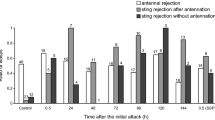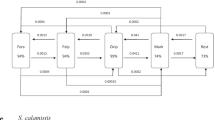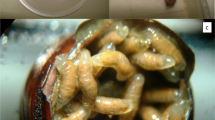Abstract
Laboratory experiments using a glass tube arena were conducted to determine the effects of aggressive behaviour of the stemborer, Chilo partellus Swinhoe (Lepidoptera: Pyralidae), on oviposition success and mortality of the parasitoid, Cotesia flavipes Cameron (Hymenoptera: Braconidae). On contacting unparasitised hosts, female parasitoids rapidly oviposited and then retreated from the experimental arena. Hosts exhibited no aggressive behaviour prior to oviposition. However, soon after being attacked, host larvae became more aggressive, spitting at and biting the parasitoids. When Co. flavipes females were introduced toward the head of the stemborer, the parasitoids stung the host near the head and were frequently bitten and killed by the hosts. Parasitoids that were introduced to the host from the posterior end of the abdomen, stung the abdomen and were often able to escape from the host without being bitten. Regardless of whether parasitoids were introduced near the head or the abdomen, they were more often killed by older hosts than younger hosts. Parasitised hosts were more aggressive than unparasitised hosts one hour after the initial parasitisation, but not after 24 hours. Larval saliva of Chilo partellus was found to reduce survival of adult female parasitoids. The aggressive behaviour of Ch. partellus was not effective as a self-defense against Co. flavipes, but is likely to be an important mortality factor of Co. flavipes in nature.
Résumé
Des essais biologiques ont été conduits dans une arène faite d’un tube en verre afin de déterminer l’effet du comportement d’agressivité du foreur de tige, Chilo partellus Swinhoe (Lepidoptera: Pyralidae), sur la ponte et la mortalité du parasitoïde, Cotesia flavipes Cameron (Hymenoptera: Braconidae). En présence d’un hôte non parasité, la femelle du parasitoïde a pondu rapidement dans l’hôte et est sortie de l’arène. Les insectes hôtes n’ont montré aucun comportement d’agressivité avant la ponte. Toutefois, aussitôt après l’attaque, les larves de l’insecte hôte sont devenues plus agressives, projetant de la salive et mordant les parasitoïdes. Lorsque les femelles de Co. flavipes ont été introduites dans la région frontale de l’hôte, celles-ci ont piquées la larve hôte près de la tête, elles ont généralement été mordues et tuées par l’insecte hôte. Les parasitoïdes qui ont été introduits dans la région abdominale de l’hôte, ont piqué l’abdomen et se sont échappées sans se faire mordre. Les parasitoïdes ont le plus souvent été tués par les larves agées que par des larves jeunes indépendamment du site d’introduction (région frontale ou abdominale). L’hôte déjà parasité s’est montré plus aggressif que l’hôte non parasité une heure après la première attaque, mais pas 24 heures après. Le salive de la larve de Ch. partellus a réduit la durée de vie des femelles du parasitoïde. Le comportement d’agressivité de Ch. partellus n’est pas efficace comme moyen d’auto-défense contre Co. flavipes, mais il est possible qu’il soit un facteur important de mortalité des parasitoïdes dans la nature.
Similar content being viewed by others
References
Godfray H. C. J. (1994) Parasitoids: Behavioural and Evolutionary Ecology. Princeton University Press. Princeton, New Jersey. 473 pp.
Gross P. (1993) Insect behavioral and morphological defenses against parasitoids. Annu. Rev. Entomol. 38, 251–273.
Harris K. M. (1990) Bioecology and Chilo species. Insect 467–477.
Hays D. B. and Vinson S. B. (1971) Acceptance of Heliothis virescens (F.) as a host by the parasite Cardiochiles nigriceps Viereck. Anim. Behav. 19, 344–352.
Ingram W. R. (1983) The lepidopterous stalk-borers associated with Gramineae in Uganda. Bull. Entomol. Res. 49, 367–383.
Kajita H. and Drake E. F. (1969) Biology of Apanteles chilonis and A. flavipes (Hymenoptera: Braconidae), parasites of Chilo suppressalis. Mushi 42, 163–179.
Ochieng R. S., Onyango F. O. and Bungu M. D. O. (1985) Improvement of techniques for mass culture of Chilo partellus (Swinhoe). Insect Sci. Applic. 6, 425–428.
Overholt W. A., Ochieng J. O., Lammers P. and Ogedah K. (1994) Rearing and field release methods for Cotesia flavipes Cameron (Hymenoptera: Braconidae), a parasitoid of tropical gramineous stem borers. Insect Sci. Applic. 15, 253–259.
Pasteels J. M. and Gregoire J. C. (1983) The chemical ecology of defense in arthropods. Annu. Rev. Entomol. 28, 263–289.
Pottings R. P. J., Osae-Danso F., Overholt W. A. and Ngi-Song A. J. (1993) Host selection in Cotesia flavipes, parasitoid of tropical stemborers. Proc. Exp. Appl. Entomol. 4, 47–52.
Smith J. W. Jr., Wiedenmann R. N. and Overholt W. A. (1993) Parasites of Lepidopteran Stemborers of Tropical Gramineous Plants. ICIPE Science Press. Nairobi, 89 pp.
Takasu K. and Overholt W. A. (1996) Oviposition behavior of Cotesia flavipes and Goniozus indicus, larval parasitoids of Chilo partellus (In Japanese with English abstract). Jpn. J. Appl. Entomol. Zool. (In press).
Author information
Authors and Affiliations
Rights and permissions
About this article
Cite this article
Takasu, K., Overholt, W.A. Aggressive Behaviour of Chilo partellus (Swinhoe) Larvae Against the Parasitoid, Cotesia flavipes Cameron. Int J Trop Insect Sci 17, 131–135 (1997). https://doi.org/10.1017/S1742758400022244
Accepted:
Published:
Issue Date:
DOI: https://doi.org/10.1017/S1742758400022244




